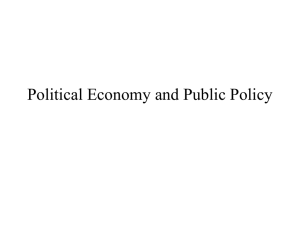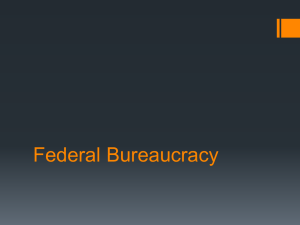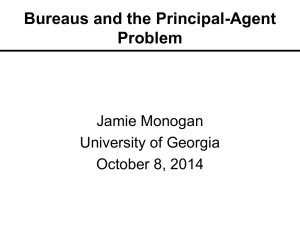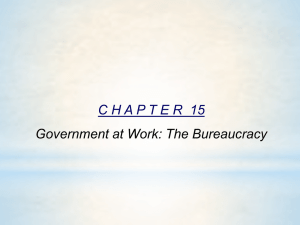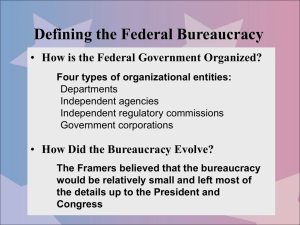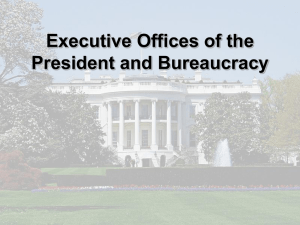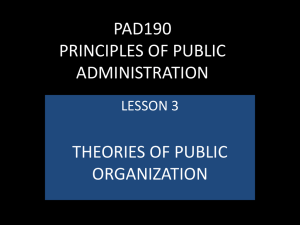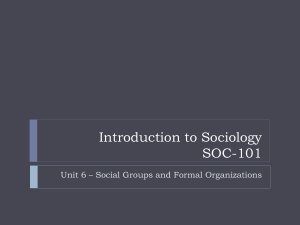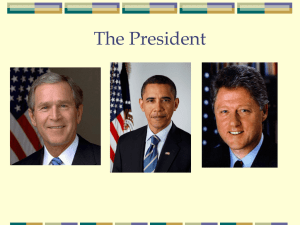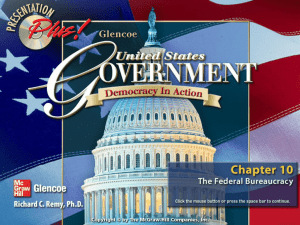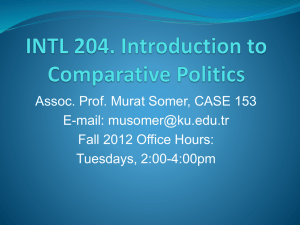bureaucracy
advertisement
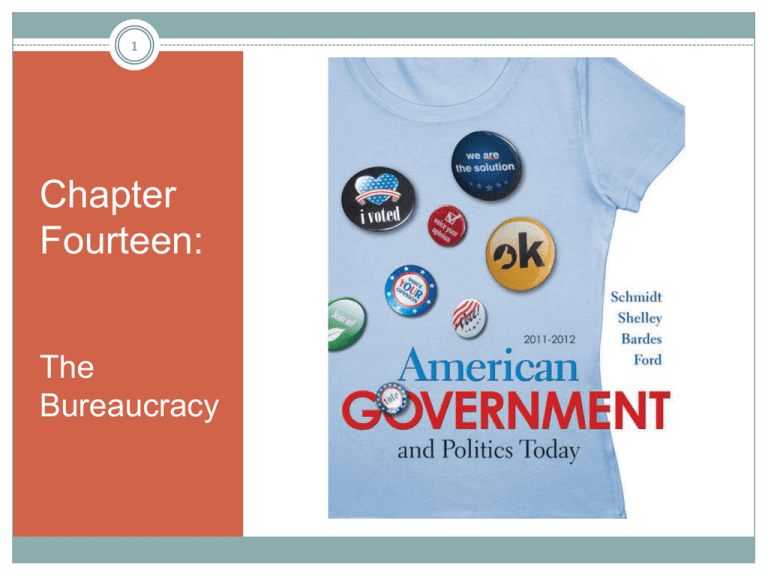
1 Chapter Fourteen: The Bureaucracy Learning Objectives 2 Explain the differences between private and public bureaucracies. Identify the models of bureaucracy. Explain how the bureaucracy has developed throughout our history. Learning Objectives 3 Identify the types of governmental organizations in the federal bureaucracy and distinguish between functions and responsibilities (including Cabinet departments, independent executive agencies, independent regulatory commissions and government corporations). Identify the legislation controlling political activity by the bureaucracy (the Civil Service Reform Act of 1883 and the Hatch Act). Learning Objectives 4 Explain Congressional control of bureaucracies, including enabling legislations and budgetary authorization. Identify the recent reforms within the federal civil service. Sunshine laws Sunset laws Whistleblowers Learning Objectives 5 Explain the iron triangle model of the bureaucracy and the role of executive agencies, subcommittees and interest groups and compare it with the issue networks model. The Nature of Bureaucracy 6 A bureaucracy is the name given to a large organization that is structured hierarchically to carry out specific functions. The Nature of Bureaucracy 7 Public bureaucracies: Do not have a single set of leaders. Supposedly serve the citizenry. Not organized to make a profit. Private bureaucracies: Have single leaders. Organized to make a profit. The Nature of Bureaucracy 8 Models of Bureaucracy Weberian model: Hierarchy Specialization Rules and regulations Neutrality Acquisitive model Monopolistic model The Size of the Bureaucracy 9 Excluding the military, the federal bureaucracy includes approximately 2.7 million government employees. Since 1970, most growth in government is at the state and local levels. The Size of the Bureaucracy 10 The Size of the Bureaucracy 11 The Organization of the Federal Bureaucracy 12 Cabinet departments: major service organizations of the federal government. Independent executive agencies: organizations that report directly to the president. The Organization of the Federal Bureaucracy 13 The Organization of the Federal Bureaucracy 14 Independent regulatory agencies: develops rules and regulation in a particular sphere of action to protect public interest. Agency Capture Deregulation and Re-regulation Government corporations: businesses created by Congress to perform functions. The Organization of the Federal Bureaucracy 15 Challenges to the Bureaucracy 16 Reorganizing to Stop Terrorism: Department of Homeland Security Dealing with Natural Disasters: Federal Emergency Management Agency (FEMA) Staffing the Bureaucracy 17 Political Appointees: The Aristocracy of the Federal Government Civil Servants: Difficult to Fire Staffing the Bureaucracy 18 History of the Federal Civil Service Spoils System: Whenever a new president was elected from a party different from the party of the previous president, there would be an almost complete turnover in the staffing of the federal government. Civil Service Reform Act of 1883: Established the principle of employment on the basis of open, competitive examinations and created the Civil Service Commission to administer the personnel service. Staffing the Bureaucracy 19 History of the Federal Civil Service (Continued) Civil Service Reform Act of 1978: Created the Office of Personnel Management (OPM), which is empowered to recruit, interview, and test potential government workers and determine who should be hired. Created the Merit Systems Protection Board (MSPB) to oversee promotions, employees’ rights, and other employment matters. Staffing the Bureaucracy 20 History of the Federal Civil Service (Continued) Hatch Act—or Political Activities Act—of 1939: prohibited federal employees from actively participating in the political management of campaigns. Modern Attempts at Bureaucratic Reform 21 Sunshine Laws Information Disclosure Curbs on Information Disclosure since September 11, 2001 Sunset Laws Modern Attempts at Bureaucratic Reform 22 Privatization Incentives for Efficiency and Productivity Helping out the Whistleblowers Laws protecting whistleblowers Problem continues Bureaucrats as Politicians and Policymakers 23 Rule-making Environment: Waiting Periods Court Challenges Negotiated Rule-Making Bureaucrats as Politicians and Policymakers 24 Iron Triangles: a three-way alliance among legislators in Congress, bureaucrats, and interest groups. Issue Networks: consists of individuals or organizations that support a particular policy. Bureaucrats as Politicians and Policymakers 25 Congressional Control of the Bureaucracy 26 Passes enabling legislation Controls funding Conducts hearings and investigations Web Links 27 USA.gov: the U.S. government's official Web portal that lists government information and services, such as telephone numbers for government agencies and personnel: www.USA.gov . Federal Register: the official publication for executive-branch documents: www.gpoaccess.gov/fr/browse.html. What If…The Public Graded Federal Bureaucracies? 28 Congress has repeatedly reformed the civil service since 1883, yet bureaucrats are far from accountable to their bosses in the executive branch, to Congress, and the public. President George W. Bush implemented a plan known as “performance-based budgeting” to increase bureaucratic accountability and to examine how well each agency met specific performance criteria. What If…The Public Graded Federal Bureaucracies? 29 Using evaluations of bureaucratic agencies is difficult: It is not always possible to cut funding of a program that is performing poorly since it may be essential. It may be performing poorly because it is underfunded—and cutting back will only make matters worse. Bad publicity might be a better tool for making bureaucrats more responsive; they might have an incentive to improve the quality of their work. What If…The Public Graded Federal Bureaucracies? 30 Many observers believe that the greatest obstacle to making the federal bureaucracy responsive is that it is very difficult to fire federal bureaucrats. If Congress could make it easier for bureaucrats to be fired, perhaps poor performance on a public report card could lead to discipline and perhaps discharge. You Can Make a Difference: What the Government Knows About You 31 The federal government collects billions of pieces of information on tens of millions of Americans each year. You may want to verify the information that the government has on you that can be important. Records of two people with similar names have become confused. Innocent persons have had the criminal records of other persons erroneously inserted into their files. Possible identity theft. You Can Make a Difference: What the Government Knows About You 32 Things You Can Do: Freedom of Information Act of 1966 (FOIA) requires that the federal government release, at your request, any identifiable information it has about you or about any other subject. The American Civil Liberties Union (ACLU) has published Your Right to Government Information. Order it online at www.aclu.org.
